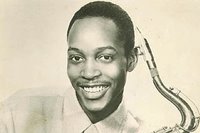Michigan's Musical Connection: Sonny Stitt
Finally ...at last, it is Saturday and I am able to bring the overdue return of Michigan's Musical Connection. Sorry for the short break from this feature everyone. I have selected jazz icon, Sonny Stitt, as the featured artist for this installment. Let's get crackin'.
 Wikipedia gets things started -
Wikipedia gets things started -
Here's some additional insight from a review page at JazzSpot
Answers.com
 Wikipedia gets things started -
Wikipedia gets things started -Edward "Sonny" Stitt (February 2, 1924 – July 22, 1982) was an American jazz saxophonist. He was a quintessential saxophonist of the bebop idiom. He was also one of the most prolific saxophonists, recording over 100 records in his lifetime. He was nicknamed the "Lone Wolf" by jazz critic Dan Morgenstern, due to his relentless touring and his devotion to jazz.
Stitt was born in Boston, Massachusetts, and grew up in Saginaw, Michigan. Stitt had a musical background; his father taught music, his brother was a classically trained pianist, and his mother was a piano teacher. His earliest recordings were from 1945, with Stan Getz and Dizzy Gillespie. He had also experienced playing in some swing bands, though he mainly played in bop bands. Stitt featured in Tiny Bradshaw's big band in the early forties.
Stitt played alto saxophone in Billy Eckstine's big band alongside future bop pioneers Dexter Gordon and Gene Ammons from 1945 until 1949, when he started to play tenor saxophone more frequently. Later on, he notably played with Gene Ammons and Bud Powell. Stitt spent time in a Lexington prison between 1948-49 on account of selling narcotics.
Here's some additional insight from a review page at JazzSpot
I feel that Sonny Stitt is currently the most underrated saxophonist of his generation. He is currently being penalized for not having recorded extensively for Blue Note or Verve, because we all know what a great job those labels are doing with dead artists. He also suffers from not having blown his own horn (autobiographically) during his life. How could he know that just weeks after subbing for the late Art Pepper at the Kool festival that he'd be joining him in the heavenly Bebop sax section?However, his peers respected his ability (just check out how many name musicians played with him in the '50s and '60s). He also has a list of near misses that might surprise you. For instance, he was nominated for two Grammy awards (back when that really meant something) and there was no media darling like Wynton Marsalis to tell people what to think.
He also missed getting into the Down Beat hall of fame posthumously in 1982 because he had the misfortune to die in the same year (albeit weeks later) as Art Pepper. He actually subbed for Pepper just weeks prior to his own death.
Answers.com
Charlie Parker has had many admirers and his influence can be detected in numerous styles, but few have been as avid a disciple as Sonny Sitt. There was almost note-for-note imitation in several early Stitt solos, and the closeness remained until Stitt began de-emphasizing the alto in favor of the tenor, on which he artfully combined the influences of Parker and Lester Young. Stitt gradually developed his own sound and style, though he was never far from Parker on any alto solo. A wonderful blues and ballad player whose approach influenced John Coltrane, Stitt could rip through an up-tempo bebop stanza, then turn around and play a shivering, captivating ballad.
Labels: Michigan's Musical Connection







0 Comments:
Post a Comment
Subscribe to Post Comments [Atom]
<< Home